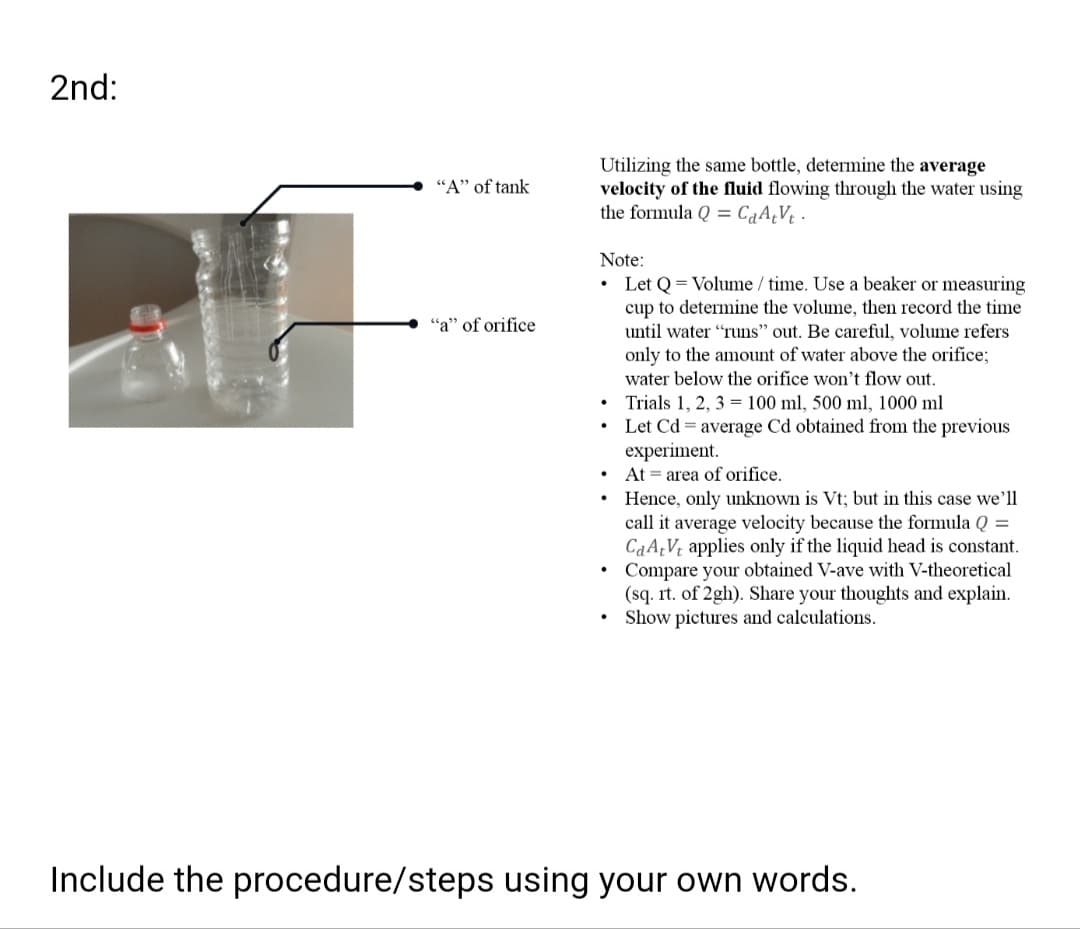Utilizing the same bottle, determine the average velocity of the fluid flowing through the water using the formula Q = C¿A¿V¢ · "A" of tank Note: • Let Q = Volume / time. Use a beaker or measuring cup to determine the volume, then record the time until water "runs" out. Be careful, volume refers only to the amount of water above the orifice; "a" of orifice water below the orifice won't flow out. • Trials 1, 2, 3 = 100 ml, 500 ml, 1000 ml • Let Cd = average Cd obtained from the previous experiment. • At = area of orifice. Hence, only unknown is Vt; but in this case we'll call it average velocity because the formula Q = CaA¿V; applies only if the liquid head is constant. Compare your obtained V-ave with V-theoretical (sq. rt. of 2gh). Share your thoughts and explain. Show pictures and calculations.
Utilizing the same bottle, determine the average velocity of the fluid flowing through the water using the formula Q = C¿A¿V¢ · "A" of tank Note: • Let Q = Volume / time. Use a beaker or measuring cup to determine the volume, then record the time until water "runs" out. Be careful, volume refers only to the amount of water above the orifice; "a" of orifice water below the orifice won't flow out. • Trials 1, 2, 3 = 100 ml, 500 ml, 1000 ml • Let Cd = average Cd obtained from the previous experiment. • At = area of orifice. Hence, only unknown is Vt; but in this case we'll call it average velocity because the formula Q = CaA¿V; applies only if the liquid head is constant. Compare your obtained V-ave with V-theoretical (sq. rt. of 2gh). Share your thoughts and explain. Show pictures and calculations.
Elements Of Electromagnetics
7th Edition
ISBN:9780190698614
Author:Sadiku, Matthew N. O.
Publisher:Sadiku, Matthew N. O.
ChapterMA: Math Assessment
Section: Chapter Questions
Problem 1.1MA
Related questions
Question
Pls do it by steps and have procedure. Thankyou

Transcribed Image Text:2nd:
Utilizing the same bottle, determine the average
velocity of the fluid flowing through the water using
the formula Q = CqA¿V¢ ·
"A" of tank
Note:
Let Q = Volume / time. Use a beaker or measuring
cup to determine the volume, then record the time
"a" of orifice
until water "runs" out. Be careful, volume refers
only to the amount of water above the orifice;
water below the orifice won't flow out.
Trials 1, 2, 3 = 100 ml, 500 ml, 1000 ml
Let Cd = average Cd obtained from the previous
experiment.
At = area of orifice.
Hence, only unknown is Vt; but in this case we'll
call it average velocity because the formula Q =
CaA¿V¢ applies only if the liquid head is constant.
Compare your obtained V-ave with V-theoretical
(sq. rt. of 2gh). Share your thoughts and explain.
Show pictures and calculations.
Include the procedure/steps using your own words.
Expert Solution
This question has been solved!
Explore an expertly crafted, step-by-step solution for a thorough understanding of key concepts.
Step by step
Solved in 4 steps

Knowledge Booster
Learn more about
Need a deep-dive on the concept behind this application? Look no further. Learn more about this topic, mechanical-engineering and related others by exploring similar questions and additional content below.Recommended textbooks for you

Elements Of Electromagnetics
Mechanical Engineering
ISBN:
9780190698614
Author:
Sadiku, Matthew N. O.
Publisher:
Oxford University Press

Mechanics of Materials (10th Edition)
Mechanical Engineering
ISBN:
9780134319650
Author:
Russell C. Hibbeler
Publisher:
PEARSON

Thermodynamics: An Engineering Approach
Mechanical Engineering
ISBN:
9781259822674
Author:
Yunus A. Cengel Dr., Michael A. Boles
Publisher:
McGraw-Hill Education

Elements Of Electromagnetics
Mechanical Engineering
ISBN:
9780190698614
Author:
Sadiku, Matthew N. O.
Publisher:
Oxford University Press

Mechanics of Materials (10th Edition)
Mechanical Engineering
ISBN:
9780134319650
Author:
Russell C. Hibbeler
Publisher:
PEARSON

Thermodynamics: An Engineering Approach
Mechanical Engineering
ISBN:
9781259822674
Author:
Yunus A. Cengel Dr., Michael A. Boles
Publisher:
McGraw-Hill Education

Control Systems Engineering
Mechanical Engineering
ISBN:
9781118170519
Author:
Norman S. Nise
Publisher:
WILEY

Mechanics of Materials (MindTap Course List)
Mechanical Engineering
ISBN:
9781337093347
Author:
Barry J. Goodno, James M. Gere
Publisher:
Cengage Learning

Engineering Mechanics: Statics
Mechanical Engineering
ISBN:
9781118807330
Author:
James L. Meriam, L. G. Kraige, J. N. Bolton
Publisher:
WILEY